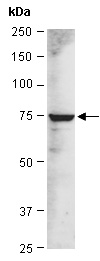Abiocode Logo
Products
Contact Us
- Telephone:
1-818-707-0309 - E-Mail:
Abiocode@Abiocode.com
R0527-4 - PAG1 (C1) Antibody, Rabbit Polyclonal
|
Quantity: 100 ul Application: WB Predicted M.W.: 47 kDa Uniprot ID: Q3U1F9 Background: Phosphoprotein associated with glycosphingolipid-enriched microdomains 1 (PAG1) is a single-pass type III membrane protein present in T cells. PAG1 negatively regulates TCR (T-cell antigen receptor)-mediated signaling in T-cells and FCER1 (high affinity immunoglobulin epsilon receptor)-mediated signaling in mast cells. PAG1 promotes CSK activation and recruitment to lipid rafts, which results in LCK inhibition. PAG1 inhibits immunological synapse formation by preventing dynamic arrangement of lipid raft proteins. PAG1 may also be involved in cell adhesion signaling. Other Names: Phosphoprotein associated with glycosphingolipid-enriched microdomains 1, Csk-binding protein Source and Purity: Rabbit polyclonal antibodies were produced by immunizing animals with a GST-fusion protein containing the C-terminal region of mouse PAG1. Antibodies were purified by affinity purification using immunogen. PAG1 (C1) (R0527-4) and PAG1 (C2) (R0527-5) are against 2 distinct C-terminal regions of PAG1, which preferentially recognize different isoforms of PAG1. Storage Buffer and Condition: Supplied in 1 x PBS (pH 7.4), 100 ug/ml BSA, 40% Glycerol, 0.01% NaN3. Store at -20 °C. Stable for 6 months from date of receipt. Species Specificity: Human, Mouse Tested Applications: WB: 1:1,000-1:5,000 (detect endogenous protein*) *: The apparent protein size on WB may be different from the calculated M.W. due to modifications.
Product Data:
|
